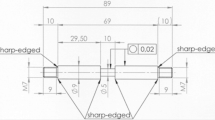Summary
The uniaxial response behavior of Hart's and Miller's nonelastic constitutive equations is compared. These models have been selected because they are fully developed and have been applied on the uniaxial nonelastic response behavior of different materials. Among these for stainless steel AISI 316 the complete set of material parameters for both models has been published. Based on these parameter sets a comparison of both models is performed including monotonic strain controlled tensile tests, creep tests, load relaxation tests and cyclic tests. The predictions of both models are compared with available experimental data.
Both models can not describe the whole range of experimental data. For Hart's model one essential flow parameter had to be adjusted to obtain a reasonable simulation of creep experiments. Further it gives unrealistic predictions for strain cycling. The incorporation of a so-called negative strain rate sensitivity severly restricts the practical applicability of Miller's model. Additionally in the high temperature regime the response curves for load relaxation tests deviate considerably from the experimentally observed ones at low strain rates. Both models have to be improved for practical applications.
Similar content being viewed by others
References
Hart, E. W.: Constitutive relations for the non-elastic deformation of metals. Trans. ASME, J. Eng. Mat. Technol.98, 193–202 (1976).
Krieg, D. R.: A physically based internal variable model for rate-dependent plasticity. In: Inelastic behavior of pressure vessels and piping components (Chang, T. Y., Krempl, E., eds.), pp. 15–28. American Society of Mechanical Engineers. New York (1978).
Miller, A. K.: An inelastic constitutive model for monotonic, cyclic and creep deformation: Part 1—Equations development and analytical procedures. Trans. ASME, J. Eng. Mat. Technol.98, 97–105 (1976).
Miller, A. K.: An inelastic constitutive model for monotonic, cyclic and creep deformation: Part 2—Application to type 304 stainless steel. Trans. ASME, J. Eng. Mat. Technol.98, 106–113 (1976).
Robinson, D. N.: A candidate creep-recovery model for 2-1/4Cr-1 Mo steel and its experimental implementation. Oak Ridge National Laboratory, Report ORNL-TM-5110 (1975).
Kumar, V., Mukherjee, S., Huang, F. H., Li, C. Y.: Deformation in type 304 austenitic stainless steel. EPRI NP-1276, Final Report, Electric Power Research Institute. Palo Alto, California 1979.
Oldberg, S. Miller, A., Lucas, G. E.: Advances in understanding and predicting inelastic deformation in zircaloy, zirconium in the nuclear industry (Fourth conference) ASTM STP 681, pp. 370–389. American Society for Testing and Materials (1979).
Tanaka, G. T.: An unified numerical method for integrating stiff time-dependent constitutive equations for elastic/viscoplastic deformation of metals and alloys. Ph. D. Dissertation, Stanford University, Dept. of Mat. Sc. and Eng. 1983.
Cordts, D., Kollmann, F. G.: An implicit time integration scheme for inelastic constitutive equations with internal state variables. Int. J. Num. Meth. Eng.23, 533–554 (1986).
Wire, G. L., et al.: A state variable analysis of inelastic deformation of thin walled tubes. Trans. ASME, J. Eng. Mat. Technol.103, 305–325 (1981).
Schmidt, C. G., Miller, A. K.: An unified phenomenological model for nonelastic deformation of type 316 stainless steel, Part I and II. Res. Mechanica3, 109–129, 175–193 (1981).
Miller, A. K.: An unified phenomenological model for the monotonic, cyclic and creep deformation of strongly work hardening materials. Ph. D. dissertation, Stanford University, Dept. of Mat. Sc. and Eng. (1975).
Miller, A., Sherby, O. D.: Development of the materials code MATMOD, Report No. EPRI-NP-567, Final report, December (1977).
Miller, A. K.: Personal Communication (1986).
Barnby, J. T., Peace, E. M.: The effect of carbides on the high strain fatique resistance of an austenitic steel. Acta Met.19, 1351–1358 (1971).
Huang, F. M., Ellis, F. V., Li, C. Y.: Comparison of load relaxation data of Type 316 austenitic stainless steel with Hart's deformation model. Met. Trans.8 A, 699–704 (1977).
Hart, E. W.: Personal communication (1986).
Thomas, J. F., Yaggee, F. L.: Stress relaxation in solution annealed and 20 pct coldworked type 316 stainless steel. Met. Trans.6 A, 1835–1837 (1975).
Streichen, J. M.: High strain rate tensile properties of 20% cold worked type 316 stainless steel. Handford Engineering Development Laboratory, HEDL-TME-74-39 (1974).
Wire, G. L., Cannon, N. S., Johnson, G. D.: Prediction of transient mechanical response of type 316 SS cladding using an equation of state approach. J. Nucl. Mat.82, 317–328 (1979).
Fahr, D.: Analysis of stress-strain behavior of type 316 stainless steel. Report ORNLTM-4292. Oak Ridge, National Laboratory (1973).
Gilbert, E. R., Blackburn, L. D.: Creep deformation of cold worked type 316 stainless steel. Hanford Engineering Development Laboratory, HEDL-SA-864 (1976).
Kollmann, F. G.: Time integration of stiff inelastic constitutive models. Proc. Int. Conf. Comp. Mech., May 25–29, 1986, Tokyo (Yagawa, G., Atluri, S. N., eds.), Vol. 1, p.IV-17–IV-24. Tokyo-Berlin-Heidelberg-New York: SPringer 1986.
Delph, T. J.: A comparative study of two state-variable constitutive theories. J. Eng. Mat. Technol., Trans. ASME102, 327–336 (1981).
Walker, K. P.: Research and development program for nonlinear structural modeling with advanced time-dependent constitive relationships. NASA-Report No. CR-165533 (1981).
Hartmann, G.: Report to Deutsche Forschungsgemeinschaft (unpublished), Technische Hochschule Darmstadt (1985).
Kubin, L. P., Estrin, Y.: The Portevin-Le Chatelier effect in deformation with constant stress rate, Acta Met.33, 397–407 (1985).
Yamada, H., Yaggee, F. L., Thomas, J. F.: Plastic deformation of 20% cold-worked type 316 stainless steel at elevated temperature. In: Proceedings 2nd International Conference on Mechanical Behavior of Materials. Boston, Mass. August 16–20, 1976, pp. 68–72. American Society for Metals (Publisher): Metals Park, Ohio (1976).
Author information
Authors and Affiliations
Additional information
With 11 Figures
Rights and permissions
About this article
Cite this article
Hartmann, G., Kollmann, F.G. A computational comparison of the inelastic constitutive models of hart and miller. Acta Mechanica 69, 139–165 (1987). https://doi.org/10.1007/BF01175718
Received:
Issue Date:
DOI: https://doi.org/10.1007/BF01175718




